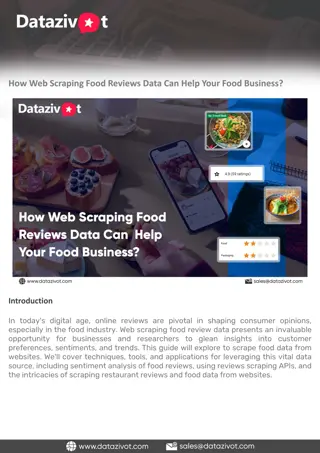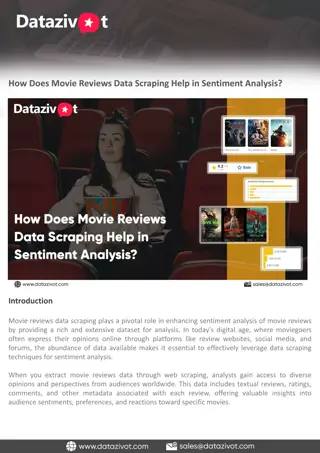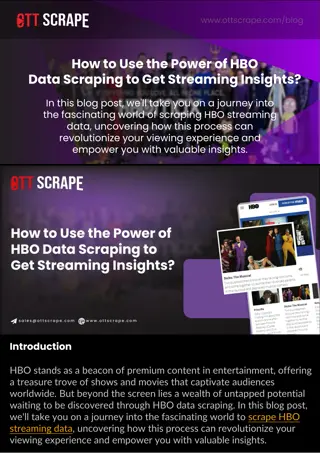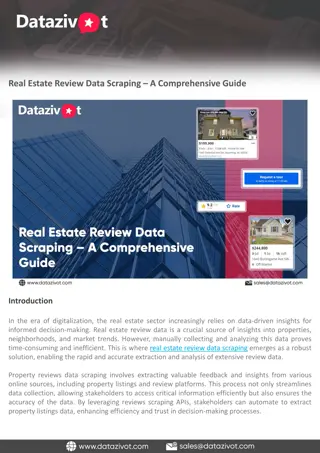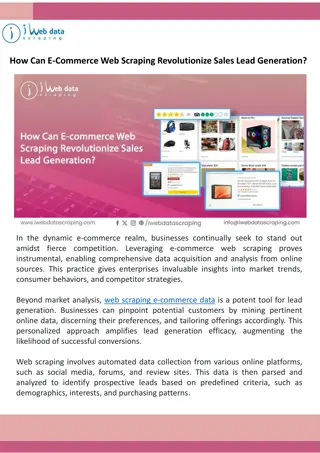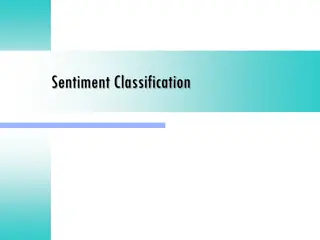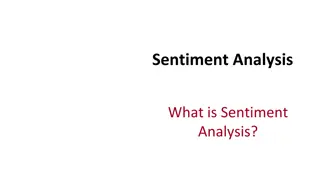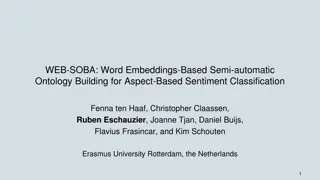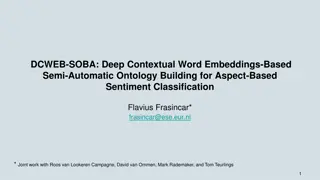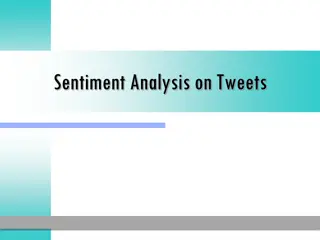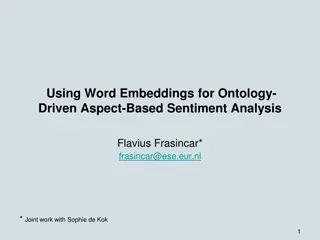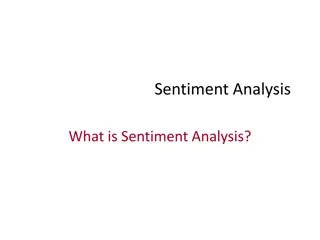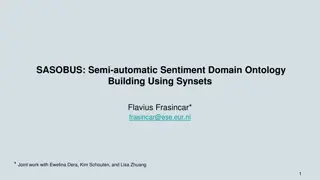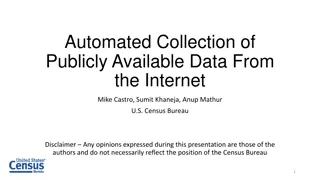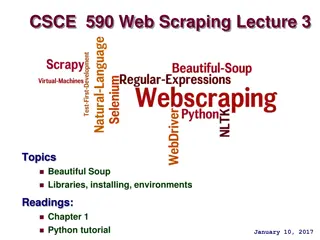Web Scraping Food Reviews Data & Sentiment Analysis– A Comprehensive Guide
Unlock insights from web scraping food reviews data. Dive deep into sentiment analysis for informed decision-making.nnknow more>>// /web-scraping-food-reviews-data-analysis.php n
Download Presentation

Please find below an Image/Link to download the presentation.
The content on the website is provided AS IS for your information and personal use only. It may not be sold, licensed, or shared on other websites without obtaining consent from the author.If you encounter any issues during the download, it is possible that the publisher has removed the file from their server.
You are allowed to download the files provided on this website for personal or commercial use, subject to the condition that they are used lawfully. All files are the property of their respective owners.
The content on the website is provided AS IS for your information and personal use only. It may not be sold, licensed, or shared on other websites without obtaining consent from the author.
E N D
Presentation Transcript
Web Scraping Food Reviews Data & Sentiment Analysis A Comprehensive Guide Introduction In today's digital age, the internet serves as a vast repository of information, offering insights into various aspects of our lives, including the food we eat. With the proliferation of restaurant review platforms and food blogs, there exists a wealth of data that can provide valuable insights experiences, and culinary trends. In this blog post, we delve into the web scraping and sentiment analysis to extract and analyze food reviews data, uncovering hidden patterns and sentiments that can inform decision-making in the food industry. into customer preferences, dining
Web Scraping Food Reviews Data Web data scraping has become an invaluable tool for businesses in various industries, including the food and hospitality sector. When it comes to understanding customer preferences and sentiments in the realm of dining experiences, restaurants reviews data scraping is particularly crucial. Here's why: Abundance of Data Sources: The internet is teeming with platforms where customers share their experiences and opinions about restaurants and dishes. Websites like Yelp, TripAdvisor, Zomato, and Google Reviews host millions of reviews from users worldwide, providing a rich source of data for analysis. Comprehensive Insights: By leveraging web data extraction techniques, businesses can gather large volumes of food reviews data from diverse sources. This enables them to gain comprehensive insights into customer preferences, trends, and sentiments across different cuisines, locations, and dining establishments. Understanding Customer Preferences: Analyzing food reviews data allows businesses to understand what customers like or dislike about specific dishes, restaurants, or dining experiences. This insight can help restaurants tailor their menus, improve service quality, and enhance the overall dining experience to better meet customer expectations.
Identifying Trends: Web extraction of food reviews data enables businesses to identify emerging trends in the food industry. By analyzing common themes, keywords, and sentiments expressed in reviews, restaurants can stay ahead of the curve and capitalize on popular food trends to attract more customers. Competitive Analysis: Monitoring and analyzing food reviews data from competitors can provide valuable insights into their strengths and weaknesses. By benchmarking against competitors, businesses can identify areas for improvement and develop strategies to differentiate themselves in the market. Scrape Customer Feedback: In addition to reviews on public platforms, web scraping can also be used to gather customer feedback from private sources, such as surveys or feedback forms on restaurant websites. This allows businesses to collect valuable insights directly from their customers and address any issues or concerns in real-time. Reviews Scraping API: Some review platforms offer APIs that allow businesses to access review data programmatically. This simplifies the process of scraping food reviews data and enables businesses to automate data retrieval, saving time and resources. Web scraping food reviews data is essential for businesses in the food and hospitality industry to gain insights into customer preferences, trends, and sentiments. By leveraging restaurants reviews data scraping, businesses can make informed decisions to improve their offerings, enhance customer satisfaction, and stay competitive in the ever-evolving food market. Scrape Food Data from Websites There are several popular websites and platforms that host food reviews, including Yelp, TripAdvisor, Zomato, and Google Reviews. These platforms provide valuable information about restaurants, including their ratings, reviews, and customer feedback. By utilizing data scraping techniques, we can extract data from these websites, including the restaurant name, reviewer's name, review text, rating, and other relevant information. Identify Target Websites: Begin by identifying the websites that host food reviews, such as Yelp, TripAdvisor, Zomato, and Google Reviews. These platforms are rich sources of data containing valuable information about restaurants and customer feedback. Understand Website Structure: Before scraping data, it's essential to understand the structure of the target websites. This includes identifying the layout of review pages, the location of relevant information such as restaurant names, reviewer names, review texts, ratings, and other metadata.
Choose Web Scraping Tools: Select appropriate web scraping tools or libraries to extract data from the target websites efficiently. Popular tools include BeautifulSoup, Scrapy, or Selenium, each offering different features and capabilities for scraping web data. Craft Scraping Scripts: Develop scraping scripts tailored to the structure of each website. This involves writing code to navigate through the website's pages, locate and extract relevant information from HTML elements, and handle pagination or dynamic content loading if necessary. Handle Anti-Scraping Measures:Some websites may implement anti-scraping measures to prevent automated data extraction. Techniques such as rate limiting, CAPTCHA challenges, or IP blocking may be encountered. It's essential to implement strategies to bypass or mitigate these measures while scraping data. Extract Relevant Data: Utilize scraping scripts to extract data from the target websites, including restaurant names, reviewer names, review texts, ratings, dates, and any other pertinent information. Ensure data integrity and accuracy during the extraction process. Store and Organize Data: Once data is extracted, store it in a structured format such as a database or spreadsheet for further analysis. Organize the data based on relevant attributes to facilitate easy retrieval and analysis. Automate Scraping Process: For ongoing data collection, consider automating the scraping process using scheduling tools or scripts. This allows for regular updates of food reviews data without manual intervention. Continuous Monitoring and Maintenance: Regularly monitor the scraping process for any errors or changes in website structure that may affect data extraction. Update scraping scripts as needed to adapt to website updates or changes in anti-scraping measures.
Scrape Customer Feedbacks Customer feedback is a valuable source of information for restaurants and food businesses. By scraping customer feedback from review platforms, restaurants can gain insights into their strengths and weaknesses, identify areas for improvement, and make data-driven decisions to enhance the overall dining experience. Moreover, aggregating feedback from multiple sources allows for a more comprehensive analysis of customer sentiment and preferences. Identify Review Platforms: Choose review platforms such as Yelp, TripAdvisor, Zomato, or Google Reviews, where customers provide feedback on restaurant experiences. Select Feedback Sources: Determine the specific restaurants or locations for which you want to scrape customer feedback. This could be based on geographical location, cuisine type, or specific business interests. Develop Scraping Scripts: Create scraping scripts tailored to the structure of each review platform to extract customer feedback data. Use web scraping tools like BeautifulSoup, Scrapy, or Selenium to automate the scraping process. Extract Feedback Data: Utilize scraping scripts to extract customer feedback data, including review texts, ratings, dates, reviewer information, and any other relevant metadata.
Aggregate Feedback: Gather feedback from multiple sources to compile a comprehensive dataset. This allows for a holistic analysis of customer sentiment and preferences across different platforms and restaurants. Analyze Customer Sentiment:Apply sentiment analysis techniques to analyze the extracted feedback data. Classify reviews into positive, negative, or neutral sentiments to identify trends, strengths, weaknesses, and areas for improvement. Identify Patterns and Trends: Look for common themes, keywords, and sentiments expressed in customer feedback to identify patterns and trends. This insight can help restaurants understand customer preferences and tailor their offerings accordingly. Address Customer Concerns: Use the insights gained from customer feedback analysis to address any concerns or issues raised by customers. This may involve improving service quality, menu offerings, ambiance, or other aspects of the dining experience. Improve Customer Experience:Make data-driven decisions based on customer feedback to enhance the overall dining experience and satisfaction levels. By continuously monitoring and responding to customer feedback, restaurants can build stronger relationships with their customers and drive loyalty. Compliance and Ethics: Ensure compliance with review platforms' terms of service and scraping guidelines when scraping customer feedback data. Respect user privacy and data protection regulations to maintain ethical data practices throughout the scraping process.
Sentiment Analysis of Food Reviews Once we have collected a significant amount of food reviews data, the next step is to analyze the sentiments expressed in the reviews. Sentiment analysis, also known as opinion mining, involves classifying the polarity of text as positive, negative, or neutral based on the sentiments expressed by the author. By applying sentiment analysis techniques to food reviews data, we can quantify customer satisfaction, identify common pain points, and uncover emerging trends in the culinary landscape. Data Collection: Begin by collecting a substantial amount of food reviews data from various sources using data scraping techniques. Gather review texts, ratings, dates, and any other relevant metadata. Preprocessing: Clean and preprocess the collected data to remove noise, such as irrelevant symbols or punctuation, and standardize text formats. This ensures consistency and improves the accuracy of sentiment analysis. Tokenization:Break down the review texts into individual words or tokens to prepare them for analysis. Tokenization allows for easier processing and analysis of text data.
Sentiment Analysis Techniques: Choose appropriate sentiment analysis techniques based on the nature of the data and the desired level of granularity. Common techniques include lexicon-based methods, machine learning models, and deep learning approaches. Lexicon-Based Analysis: Utilize sentiment lexicons or dictionaries containing words with pre- assigned sentiment scores to classify review texts as positive, negative, or neutral based on the presence of sentiment-bearing words. Machine Learning Models: Train supervised machine learning models using labeled data to classify reviews into sentiment categories. Algorithms such as Support Vector Machines (SVM), Naive Bayes, or Random Forests can be used for this purpose. Deep Learning Approaches: Explore deep learning techniques such as Recurrent Neural Networks (RNNs) or Convolutional Neural Networks (CNNs) for more advanced sentiment analysis tasks. These models can capture complex patterns and dependencies in text data. Evaluation: Assess the sentiment analysis model's effectiveness using metrics like accuracy, precision, recall, and F1-score. Refine model parameters and features for improved performance. Interpretation:Interpret the results of sentiment analysis to gain insights into customer satisfaction levels, prevalent sentiments, and emerging trends in food reviews. Identify common pain points or areas for improvement based on the analysis. Actionable Insights: Use the insights gained from sentiment analysis to inform business decisions and strategies. Address negative feedback, capitalize on positive sentiments, and adapt offerings to meet customer preferences effectively.
Analyzing Customer Sentiments Sentiment analysis algorithms typically use natural language processing (NLP) techniques to analyze text data and determine the sentiment conveyed by the words and phrases used in the reviews. These algorithms may employ machine learning models trained on labeled datasets to classify reviews into positive, negative, or neutral categories based on the language used and the context of the review. Additionally, sentiment analysis can involve extracting key aspects or topics mentioned in the reviews and analyzing the sentiment associated with each aspect. Natural Language Processing (NLP) Techniques: Sentiment analysis utilizes NLP techniques to process and analyze text data extracted from food reviews. These techniques include tokenization, part-of-speech tagging, parsing, and semantic analysis to understand the structure and meaning of the text. Sentiment Classification: Machine learning models are employed to classify reviews into predefined sentiment categories such as positive, negative, or neutral. These models are trained on labeled datasets where each review is associated with its corresponding sentiment label.
Training Data: Labeled datasets consist of reviews annotated with sentiment labels by human annotators. These datasets serve as training data for machine learning algorithms to learn patterns and relationships between text features and sentiment labels. Feature Extraction: Text features such as words, phrases, or n-grams are extracted from the reviews to represent the input data for sentiment analysis. These features are transformed into numerical representations using techniques like bag-of-words or TF-IDF (Term Frequency-Inverse Document Frequency). Machine Learning Models: Various machine learning algorithms such as Support Vector Machines (SVM), Naive Bayes, Logistic Regression, or Neural Networks are used for sentiment classification. These models learn to predict the sentiment of unseen reviews based on the features extracted from the training data. Contextual Analysis: Sentiment analysis algorithms consider the context in which words and phrases are used in the reviews to accurately determine the sentiment conveyed. Contextual information helps distinguish between positive and negative sentiments expressed in ambiguous phrases. Aspect-Based Sentiment Analysis: In addition to overall sentiment classification, sentiment analysis can involve identifying key aspects or topics mentioned in the reviews, such as food quality, service, ambiance, or pricing. The sentiment associated with each aspect is analyzed separately to provide more granular insights into customer sentiments. Scalability and Efficiency: Sentiment analysis algorithms are designed to handle large volumes of text data efficiently. Techniques such as parallel processing, distributed computing, and optimization algorithms ensure scalability and speed in analyzing customer sentiments extracted from food reviews. Evaluation Metrics: Performance of sentiment analysis algorithms is evaluated using metrics such as accuracy, precision, recall, and F1-score. These metrics measure the algorithm's ability to correctly classify reviews into sentiment categories and its overall effectiveness in sentiment analysis tasks.
Applications: Analyzing customer sentiments extracted from food reviews enables businesses to gain valuable insights into customer preferences, satisfaction levels, and areas for improvement. These insights inform decision-making processes, marketing strategies, menu planning, and service enhancements to enhance the overall dining experience and drive customer satisfaction. Conclusion Datazivot harnesses the power of web scraping and sentiment analysis to extract and analyze food review Scraping API the vast internet landscape. With Datazivot's capabilities, businesses in the food industry can unlock actionable insights into customer preferences, sentiments, and trends. By leveraging these techniques, businesses can make informed decisions to enhance the dining experience and drive business growth. As the digital landscape evolves, integrating us into business strategies becomes increasingly vital for staying competitive in the dynamic food industry. Elevate your business with us today and transform raw data into actionable intelligence for a thriving dining experience!




